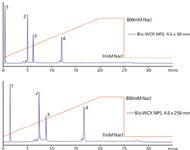Practical Advice for High Throughput Ion Exchange Separations using Non-porous Particles
The Application Notebook
Ion exchange is a perfect technique for analyzing large biomolecules such as proteins, peptides and oligonucleotides. These complex compounds contain numerous components (amino acids, nucleotides, glycans etc.) many of which possess a charged side chain or backbone.
Ion exchange is a perfect technique for analyzing large biomolecules such as proteins, peptides and oligonucleotides. These complex compounds contain numerous components (amino acids, nucleotides, glycans etc.) many of which possess a charged side chain or backbone. The non-denaturing conditions required for ion-exchange allow the biomolecule to be analyzed intact in its native state.
Traditional sorbents for ion-exchange are large diameter, porous or permeable particles which require relatively slow flow rates and long columns in order to provide sufficient resolution. Chromatographic gradients may require prolonged run times of up to an hour or more in some cases. There have been numerous advances in particle technology which means throughput can be increased significantly. The use of non-porous particles such as those utilized in Agilent's Bio IEX range based on polystyrene crosslinked with divinylbenzene reduces band broadening improving peak shape and resolution. The ion exchange functionality is introduced in a grafted hydrophilic polymer layer which helps eliminate non-specific binding.
Furthermore, using smaller particles sizes leads to greater improvements in peak shape, but at the expense of back pressure. Columns packed with 3 µm or even sub-2 µm particles require much shorter column lengths: 5 cm compared to 15 cm or 25 cm. These benefits are illustrated in Figure 1 where, despite the shorter column length, the 3 µm particle size gives sharper peaks under the same elution conditions. It is therefore possible to reduce the gradient time considerably to achieve a much higher throughput.

Figure 1: Protein Separation Bio WCX NP5 4.6 Ã 250 mm vs. Bio WCX NP3 4.6 Ã 50 mm (1.0 mL/min).
Experimental
Columns: Agilent Bio WCX NP5, 4.6 × 250 mm SS Agilent Bio WCX NP3, 4.6 × 50 mm SS
Mobile phase: A: 20 mM sodium phosphate, pH 6.5 B: A + 1.6 M NaCl
Gradient: 0 – 50% B
Temperature: Ambient
Injection volume: 10 µL
Sample: Ovalbumin (1), Ribonuclease A (2), Cytochrome c (3), Lysozyme (4)
Concentration: 0.5 mg/mL
Detection: UV, 220 nm
Instrument: Agilent 1260 Infinity Bio-inert Quaternary LC system
Results and Discussion
Simply translating the gradient time in accordance to the difference in column volume (4.6 × 250 mm vs. 4.6 × 50 mm) means it is possible to reduce a 20 min gradient to just 4 min. As can be seen in Figure 2, the analysis time can be reduced by 80% without any further alterations to the method. However at such short run times it may become necessary to significantly increase data collection rates and optimize instrument parameters (detection response times, cell volume and other internal connections) in order to truly maximize the benefit of high speed analysis.

Figure 2: High Speed Protein Separation Bio WCX NP3 4.6 Ã 50 mm (1.0 mL/min); 0â20 min gradient vs. 0â4 min gradient.
Agilent Technologies, Inc.
5301 Stevens Creek Blvd., Santa Clara, CA 95051
(800) 227-9770 (Directory), fax (866) 497-1134
Website: www.agilent.com
















